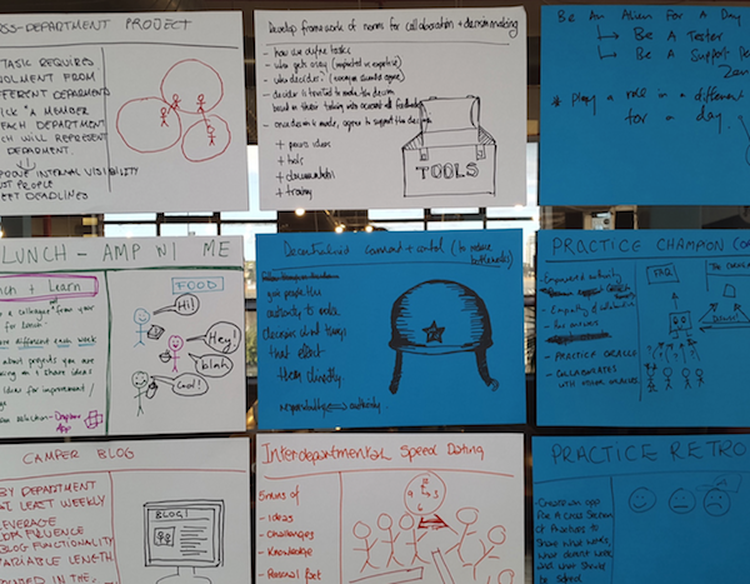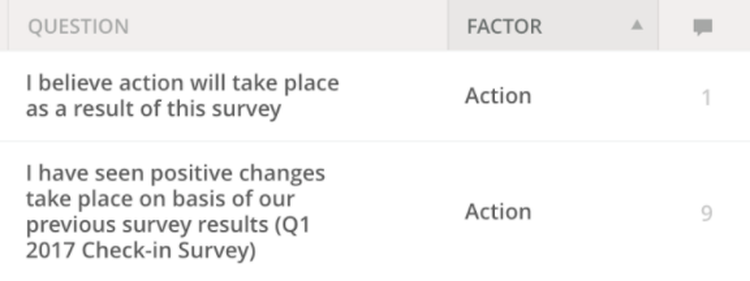
5 agile feedback methods to help you take action

Written by

Former Customer Success Lead, Culture Amp
Imagine an office bursting with Kanban boards, metric dashboards, user stories, and a rainbow of Post-It notes describing ideas, pieces of work, and measures of success. Rough concepts are put in front of stakeholders within days (not weeks), and an 80:20 approach allows ideas to evolve more quickly.
This was my first experience working in an agile environment. If you looked around, agile was everywhere. The space felt more creative and alive than any I’d been in, and with that energy and momentum, we felt more able to focus on solving customer problems.
For those new to the concept, agile is a software delivery methodology focused on shorter release cycles, iterative development, intense customer-centricity, and a faster time to value.
Now, many organizations have adopted agile in one way or another, whether they have engineering teams delivering code or are experimenting with customer-focused agile feedback (a concept we explore in our ebook, An agile approach to employee feedback).
Using agile to accelerate action
At Culture Amp, we work with some of the most innovative companies in the world. In working with them, I’ve seen agile techniques used to act more quickly and impactfully on employee feedback.
Agile is especially helpful after rolling out organization-wide surveys like engagement and pulse surveys. This is often when organizations have identified a set of focus areas and are putting initiatives in place to act on them.
Five ways you can apply agile feedback methods
While there are broader implications for adopting an agile strategy to your overall employee feedback approach, I’ve outlined five ways to adopt an agile approach to acting on your feedback. To do this, I’ve unpacked some of the twelve principles of agile.
Agile principle 1: Our highest priority is to satisfy the customer through early and continuous delivery of valuable software.
Agile prioritizes delivery and making progress – over comprehensive documentation and planning – with a view to putting ideas in the hands of customers faster.
In the context of acting on employee feedback after a survey closes, this momentum is critical; that’s why we encourage companies to send thank you notes as soon as the survey closes and to share results sooner rather than later.
Once you’ve identified your focus area, force yourself to a shorter timeframe to put rough solutions in front of employees (or better yet, collaborate with employees to design a solution). A month of planning could, in reality, cause you to lose out on a month’s worth of feedback and collaboration opportunities with your employees.
Agile principle 5: Build projects around motivated individuals. Give them the environment and support they need, and trust them to do the job.
Strong participation is a good sign that employees want to provide input to help the organization be better. Where many organizations fall short is failing to continue the involvement from the survey to the action stage.
Empowering employees to identify and drive action from surveys can shepherd change far more effectively than a top-down approach. One way to do this is to engage the organization in an ideation process, where opportunities are re-framed as questions (e.g., How might we help people access a wider variety of learning experiences in their day-to-day roles?) Doing this can give people the space to think creatively and identify initiatives that can have a more significant impact than applying a cookie-cutter "best practice" approach.
Leaders and the HR team have a significant role to play in creating an empowered environment and removing blockers so employees can drive change. This concept in agile is referred to as servant leadership, and you can prepare leaders to play this role ahead of your results rollout. More formal approaches like frontline ambassadors, change champions, and cross-functional forums can also bridge the gap between the top-down changes and teams on the ground.
Principle 8: Agile processes promote sustainable development. The sponsors, developers, and users should be able to maintain a constant pace indefinitely.
The notion of pulsing more frequently (say monthly) is quite topical, but it’s easy to be tripped up by this more frequent cadence and not have the time to take meaningful action. Even if action is taken, there often isn’t enough time for people to understand its value. People don’t get survey fatigue, they get lack of action fatigue.
A good survey strategy should have a cadence reflecting an indefinitely sustainable learning pace, acting, and repeating. People should feel there’s been enough time to dive into results, act on those results, and perceive a change in the organization before another survey comes out.
Agile principle 10: Simplicity – the art of maximizing the amount of work not done- is essential.
This one can’t be underestimated. Many survey programs and action plans fail because they are unnecessarily complicated. Organizations can move quickly by adopting approaches that allow them to simplify the documentation that needs to be created and focus on delivering outcomes.
Some of these concepts include:
- Minimum viable product (MVP): The minimum is done to satisfy a customer requirement or meet a specific outcome
- Sprints: Chunking down work into two-week timeframes with a focus on short-term delivery
- Kanban or agile boards: Tools to make work progress more visible and lightweight/easily updated

Beyond these approaches, encourage the organization (and especially leaders) to adopt a "keep it simple" mindset. Focus on one to two action areas from your survey results. Inspire people to act and give them an opportunity to co-create solutions to test and iterate in the business. Have conversations with your employees. Or, as our Chief Scientist, Dr. Jason Macpherson, says, simply do something.
Principle 12: At regular intervals, the team reflects on becoming more effective, then tunes and adjusts its behavior accordingly.
Retrospectives are a fantastic way to carve out dedicated time to reflect, learn, and identify things you want to improve in the future. You can get an indication of how people perceive action through your surveys (see action questions below). Still, the people and culture team should run retros to reflect and learn about the survey process and how they support the business to act.

Retros don’t need to be complicated. You can jump in a room (with the HR team and some representatives from the business) and have people reflect on things that worked well and didn’t work well in the rollout, with a view to selecting one or two things to change next time.
Getting started and making your own conclusions
There are seven more principles of agile you can learn from and an endless number of impactful applications that can help HR teams act quickly. You'll come to your conclusion on what works best for your team.
HR teams should focus on understanding the concepts of the methodology and discussing how these concepts might disrupt or apply to their approach to acting on survey feedback. To get started, review the Agile Manifesto and the twelve principles of agile. Grab a clean whiteboard and a bunch of Post-Its and discuss how each principle might apply in the case of acting on survey feedback or what implications there might be that you can learn from.
Choose one or two new approaches to try the next time you support the organization to act on survey feedback. Maybe it’s applying an MVP and sprint concept, or perhaps it’s creating a diverse forum of people to co-design the actions that will be taken. Finally, make sure you carve out time to reflect and learn - even with only this one change, you’ll continually improve how you act on employee feedback.




